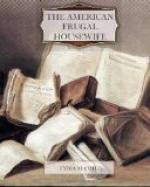Liver is usually much despised; but when well cooked, it is very palatable; and it is the cheapest of all animal food. Veal liver is by some considered the best. Veal liver is usually two cents a pound; beef liver is one cent. After you have fried a few slices of salt pork, put the liver in while the fat is very hot, and cook it through thoroughly. If you doubt whether it be done, cut into a slice, and see whether it has turned entirely brown, without any red stripe in the middle. Season it with pepper and salt, and butter, if you live on a farm, and have butter in plenty. It should not be cooked on furiously hot coals, as it is very apt to scorch. Sprinkle in a little flour, stir it, and pour in boiling water to make gravy, just as you would for fried meat. Some think liver is better dipped in sifted Indian meal before it is fried. It is good broiled and buttered like a steak. It should be cut into slices about as thick as are cut for steaks.
The heart, liver, &c. of a pig is good fried; so is that of a lamb. The latter is commonly called lamb-fry; and a dinner may be bought for six or eight cents. Be sure and ask for the sweet-bread; for butchers are extremely apt to reserve it for their own use; and therefore lamb-fry is almost always sold without it. Fry five or six slices of salt pork; after it is taken out, put in your lamb-fry while the fat is hot. Do it thoroughly; but be careful the fire is not too furious, as it is apt to scorch. Take a large handful of parsley, see that it is washed clean, cut it up pretty fine; then pour a little boiling water into the fat in which your dinner has been fried, and let the parsley cook in it a minute or two; then take it out in a spoon, and lay it over your slices of meat. Some people, who like thick gravies, shake in a little flour into the spider, before pouring in the boiling water.
Bones from which roasting pieces have been cut, may be bought in the market for ten or twelve cents, from which a very rich soup may be made, besides skimming off fat for shortening. If the bones left from the rump be bought, they will be found full of marrow, and will give more than a pint of good shortening, without injuring the richness of the soup. The richest piece of beef for a soup is the leg and the shin of beef; the leg is on the hind quarter, and the shin is on the fore quarter. The leg rand, that is, the thick part of the leg above the bony parts, is very nice for mince pies. Some people have an objection to these parts of beef, thinking they must be stringy; but, if boiled very tender, the sinews are not perceived, and add, in fact, to the richness of a soup.
The thick part of a thin flank is the most profitable part in the whole ox to buy. It is not so handsome in appearance as some other pieces, but it is thick meat, with very little bone, and is usually two cents less in the pound than more fashionable pieces. It is good for roasting, and particularly for corning and salting. The navel end of the brisket is one of the best pieces for salting or corning, and is very good for roasting.




